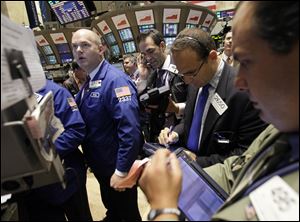
Stocks sizzle in September, but gains termed deceptive
10/1/2010
Despite economic doldrums, the stock market put together an 11 percent upswing in the past quarter, largely driven by a relatively small number of traders playing with a lot of money.
When you open your quarterly financial statements in the next few weeks, you might be both pleased and puzzled.
Despite the economic doldrums, the stock market put together a sizzling 11 percent return over the past three months, including its best September since 1939. For a time Thursday, the Dow Jones industrial average appeared headed for 11,000.
But the gains are deceptive, market analysts say. While news about the economy has improved, there's no reason to believe it's roaring back. And the big advance was driven by a relatively small number of traders playing with a lot of money.
"I think a lot of this is just misguided optimism," says Rob Arnott, chairman of Research Affiliates, an investment firm in Newport Beach, Calif.
"The headwinds we face are pretty daunting."
In other words, few are calling it the beginning of the next bull market - not with unemployment still near 10 percent and stocks bound in what market technicians call a trading range.
Thursday's results were headed up, but then ended down slightly. The Dow fell 47 points to 10,788.05. The Standard & Poor's 500 index dropped 3.53 to 1,141.20, and the Nasdaq composite declined 7.94 to 2,368.62.
Still, the gains for the month were impressive. In September alone, the S&P 500 index rose 9 percent, the Dow almost 8 percent, and the Nasdaq composite index 12 percent. Every sector of the market was up.
September is usually the market's worst month. This time, it was the third-best month of any kind in 10 years, narrowly trailing only March, 2003, and April, 2009, when stocks were bouncing back from meltdowns.
So why the rally? Economic news, while not great, was at least enough to dispel fears of a so-called double-dip recession.
The quarter got off to an inauspicious start. On the very first day of July, stocks dipped to what remains their low point of 2010: 1,011 for the S&P 500 index and 9,596 for the Dow in intraday trading.
After rebounding to finish July up 7 percent, the market limped through August. The S&P 500 fell nearly 5 percent, and the major indexes wiped out any gains for the year.
But then there was more of a rebound. While the gains did a lot for millions of 401(k) accounts and other investment holdings, the rally was rather thin, and some market observers say that's a sign it won't last.
Volume on the New York Stock Exchange has been unusually low for the last several weeks. And two important sectors - financial and health-care stocks - have been lagging the others, showing signs of weakness that mirror the economy.
Everyday investors are still scarred from 2008, when some had more than half of their holdings wiped out during the meltdown.
About half of American households own stocks, directly or indirectly, and many remain skittish because of the "flash crash" this May, when the Dow plunged nearly 1,000 points in minutes.
Regulators are still investigating the sudden nose dive, which may have been triggered by computerized trading.